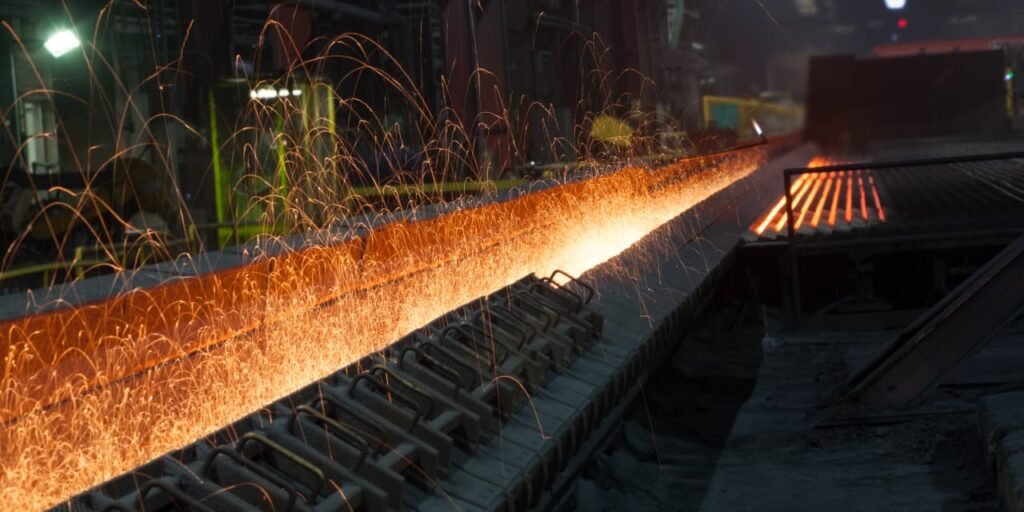It has been a long time since United States Steel lived up to its illustrious name.
Once the largest company in the world, a true corporate colossus, it has been all downhill for
U.S. Steel
for more than a half-century. It was dethroned as the global No. 1 steel maker in 1970, booted from the
Dow Jones Industrial Average
in 1991, and relegated to the
S&P MidCap 400
in 2014.
By 2022, U.S. Steel had fallen to 27th in global steel output, making it almost a bit player on the world stage. Its output of 14.49 million tons was just a ninth that of the world’s current No. 1, China Baowu Steel. Even in America, it trailed two other steel companies in production. But U.S. Steel’s Dec. 18 agreement to sell to Japan’s
Nippon Steel
for $14.1 billion, and the heated opposition the deal faces, is giving it one more star turn. It’s had quite a run.
U.S. Steel’s story begins, like so many American business stories, with J. Pierpont Morgan.
In 1901, Morgan financed the merger of the nation’s three leading steel makers, including Carnegie Steel, into a new titan that controlled two-thirds of the booming U.S. market. The aptly named U.S. Steel tightened its grip through ownership of mines, railroads, and Great Lakes shipping.
Cries of monopoly were met, in 1911, with a House investigation led by trustbusting Rep. Augustus Owsley Stanley, a Kentucky Democrat.
Witnesses were less than forthcoming. Andrew Carnegie, the retired “ironmaster” who made Pittsburgh synonymous with steel, “professed to be ‘blissfully ignorant of the details’ ” of his own company, the
New York Times
reported from the hearings on Jan. 11, 1912.
But Carnegie knew enough to see he got bamboozled by Morgan. “What a fool I was to sell out to the Steel Corporation for only $420 million!” he exclaimed.
(Carnegie later sent the committee a bill for $28, covering mileage and witness fees at $2 a day; it was rejected.)
The Steel Corporation, as it was known on Wall Street, escaped the fate of Standard Oil, which in 1911 was broken up by regulators. Instead, U.S. Steel continued to operate like a market bully, making enemies with hardball tactics.
Hostile to organized labor from the beginning, U.S. Steel helped crush the Great Steel Strike of 1919, when some 350,000 steelworkers nationwide walked off the job. Demands to end the 12-hour workday went unmet, and the industry remained union-free for another 15 years.
Investors had their issues, too, particularly with the company’s refusal to pay a dividend. That prompted Clarence Barron to write in this magazine in 1926 that the “Steel Corporation has been altruistic to every interest except its common stockholder.”
Perhaps public perception of the company is best summed up in the popular midcentury phrase, “Rooting for the Yankees is like rooting for U.S. Steel.” The baseball team and the steel maker were both successful but hard to love.
U.S. Steel’s power and prestige peaked in the 1940s and ‘50s, when it helped build the U.S.’s World War II war machine, and then aided in the rebuilding of war-torn Europe.
But its output peaked at around 35 million tons and plateaued, even as global steel production soared. Then, in 1970, the once unthinkable happened.
“[I]t seems clear that by now Nippon Steel is ‘ichiban’—the global leader in the grey metal,” Barron’s wrote on Sept. 14, 1970.
Nippon Steel, the same company now proposing to digest U.S. Steel, was created through the merger of Japan’s two largest steel makers. Their history also dates to 1901, when the rapidly industrializing Japanese empire established its first modern blast furnace in Yawata.
Dubbed the “Nipponese Pittsburgh” by The Wall Street Journal, Yawata was soon producing 90% of the nation’s steel, much of it used to equip the modern, Western-style military that Japan fought with in World War II. So essential was Yawata to Japan’s war efforts, it was targeted in strategic allied bombing campaigns.
Japanese industry was in ruins after the war, but it rebuilt with modern, efficient technology. Between 1950 and 1970, Japan’s steel-making capacity grew at an annual rate of 15%, according to Barron’s, compared with a 2.2% rate for the U.S. and Canada.
Amid a “business slowdown in the U.S.,” Barron’s wrote, “here in the Land of the Rising Sun, Nippon Steel and other steel makers are expanding like there’s no tomorrow.”
This was the start of the so-called Japanese miracle economy, which caused such teeth-gnashing in the U.S., before it gave way to the Japan’s “lost decade” of the ‘90s.
Foreign competition wasn’t U.S. Steel’s only worry.
In 1969, a former car company turned nuclear-services provider bought an electric arc furnace—a smaller, cheaper alternative to traditional blast furnaces, like U.S. Steel’s—and started making steel from scrap metal in North Carolina. Earnings soared, and within a few years the company renamed itself Nucor.
On the strength of its cheaper technology,
Nucor
is now the U.S.’s largest steel maker, and 16th in the world, producing 20.60 million tons in 2022.
Cleveland-Cliffs,
which was outbid for U.S. Steel by Nippon, is America’s No. 2 at 16.8 million tons.
U.S. Steel’s output of 14.49 million tons could be pushed to 20 million, said Nippon Steel, which is targeting 100 million tons combined. That would elevate the Japanese company to No. 2 in the world, ahead of European-Indian steel maker
ArcelorMittal
(68.89 million tons), and within shouting distance of industry leader China Baowu (131.84 million tons).
But the deal is no sure thing. The Biden administration is calling for scrutiny of the transaction, joining a chorus of politicians and pundits suddenly singing the praises of America’s onetime corporate bully. Rooting for U.S. Steel seems a lot easier these days.
Write to editors@barrons.com
Read the full article here
